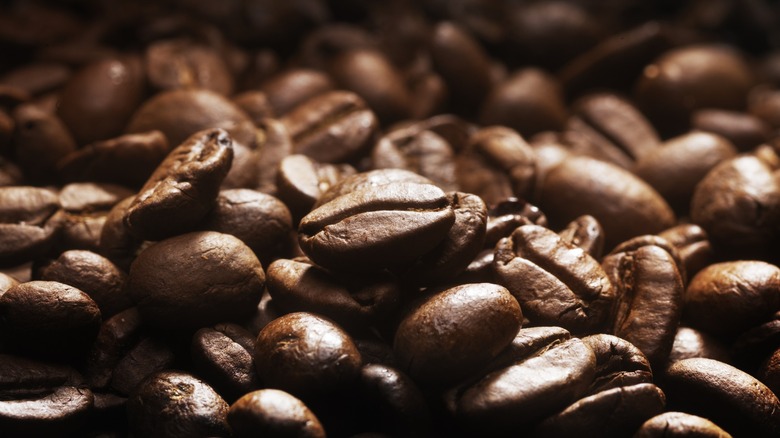Coffee Vs Espresso Beans: What's The Difference?
We may receive a commission on purchases made from links.
Most coffee connoisseurs know the difference between drinking a cup of coffee and drinking a shot of espresso. If not, it can be a shock when experiencing the flavor, density, and intensity of an unadorned espresso drink sans a lot of cream and sugar. But long before any type of coffee begins bubbling, brewing, steeping, or expressing into a cup, the flavor wheel is turning. And it all starts with the beans themselves.
As it turns out, how you prepare the coffee drink is secondary to how the coffee beans get roasted, as well as how they're eventually ground. Somewhere in that magic circle of java precision, beans receive their designations as either espresso beans or coffee beans in varying roast levels, from light to medium, dark, or extra dark. Paired with the chosen grind levels, this is what makes a core difference in the espresso and coffee drinks you love, well before they're embellished with foams, sweeteners, and flavors.
Intricacies abound in the ever-fascinating journey from coffee cherry to roasted coffee beans, and, finally, to that steaming elixir in your cup. But a cut-to-the-chase explanation helps define the core differences between espresso and coffee beans. First comes the roasting. While they start out the same, espresso beans get roasted considerably longer than standard coffee beans, reaching what's considered a dark or extra dark roast level. Second, there's the grind. While coffee beans get a course grind, espresso beans are under the blades longer, creating a medium-fine or ultra-fine consistency with a powdery texture.
A bean is just a bean, until you roast and grind it
Fortunately, a general, though sometimes subjective, industry standard applies to coffee labeling. You can expect that espresso beans carry intense, complex flavor that's rich and bold, a result of high roasting temperatures. They're also oily to the touch, which happens when prolonged exposure to high heat encourages more oil extraction and the development of deeper flavors. You may also notice an extra thick layer of crema on top of fresh espresso, which happens when those natural oils get emulsified. Standard coffee beans receive labels indicating roast levels from light to medium, determined mostly by length of time in the roaster.
Light brown beans have little if any oily sheen, typically excelling in mild coffee drinks, iced coffees, or cold brew extractions. Medium roasts, on the other hand, provide more nuanced coffee brews, bringing out natural flavors based on bean origins and profiles. Less time under the heat helps retain those natural characteristics, compared to the higher heat and longer roasts needed to produce bold espresso beans. When you're ready to use your home coffee grinder to grind those beans, regardless of how they've been roasted, it's again about time.
Less time in a grinder equals a coarser powder, resulting in ground beans fit for standard coffee brews. The longer the grind, the more fine, dense, and compact the powder will be — in other words, perfect for espresso drinks. However, even within the espresso-grind category, the specific extraction method also matters. For example, a medium-fine grind is generally best when making stovetop espressos, while finer grinds encourage more oil and flavor extraction when using modern day electric espresso machines. Still, you should be careful not to grind your espresso beans too finely as it impairs the brewing process.

